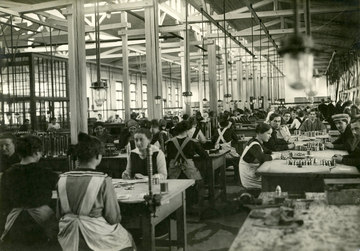The Path to 12 November: ‘If there is no peace then there will be a revolution here’
The collapse of the Monarchy was preceded by mass strikes by the workforce. The one which was most successful and had the most consequences was the ‘January strike’ in 1918, which began in Wiener Neustadt on the morning of 14 January as a result of the very slow progress of the peace negotiations in Brest-Litovsk and the catastrophic food and fuel supply situation. It spread to other factories and hence paralyzed the production of material needed for the war.
From the starvation winter of 1916-17 strikes by the workers in war industry enterprises were on the increase. Changing many industrial sites over to the needs of the wartime economy had many different and lasting consequences. The increasing employment of women, juveniles and forced labour led to a massive change in the social structure of the workforce, which manifested itself in forms of political agitation hitherto unknown. Women, who had taken over the role of providers for the family on the home front, were now time and again the first ones to initiate protest campaigns as a reaction to the precarious food supply situation.
On 14 January 1918 the government reduced the flour ration by half. This led immediately to the workers in the Daimler Engineering Works in Wiener Neustadt spontaneously going on strike. At midday the employees of the other industrial and armaments plants in the town joined them. On the next day the strike movement spread rapidly to other factories in Lower Austria and in Vienna, and on the following days to factories in Poland and Hungary. The strikes reached their climax on 20 January, with up to 750,000 workers in the Monarchy reportedly having been on strike.
The main demand of the strike movement was the immediate conclusion of a peace agreement with Russia. On 16 January the Social Democratic Party reacted by publishing in their newspaper, the Arbeiter-Zeitung, a radical manifesto, which mentioned the ‘selfishness of the owning classes’, described the bureaucratic administration as ‘bungling and corrupt’, and ended with the demand for a peace agreement: ‘We want the war to end as quickly as possible! We want a peace without conquests, either overt or covert! We want a peace on the basis of the right of peoples to genuine self-determination!’ The effect of the manifesto was twofold: it led to the strikes spreading and to Emperor Karl sending a telegram to his Foreign Minister, Count Ottokar Czernin, in which he urged the speedy conclusion of a peace agreement, because ‘if there is no peace there will be a revolution here, however much there still is to eat. This is a serious warning in serious times.’
There followed a further package of demands from the Social Democrats, whereupon Foreign Minister Czernin published a statement promising concessions (peace without conquests on the basis of the right of peoples to self-determination, reforms to the laws regulating wartime service and food supply) – these promises announced by the government were, however, not fulfilled. Then the Workers’ Council, which co-ordinated the strikes at local level and conducted negotiations, adopted by majority, following a controversially conducted discussion, a resolution of the executive of the Social Democratic Party which called for an end to the strikes. After one week, on 21 January, the strike front broke up, the process being speeded up by the arrest of numerous activists. However, the author of numerous flyers was not caught. He later surfaced again in November as a member of the Red Guard when the Republic was proclaimed in front of the Parliament building: Egon Erwin Kisch, who had made a name for himself as an investigative journalist before the war when he had uncovered the Redl spy affair and afterwards was to go down in history as the ‘racing reporter’ because of his travel reports.
Translation: Leigh Bailey
Hautmann, Hans: Jänner 1918 – Österreichs Arbeiterschaft in Aufruhr. Unter: http://www.klahrgesellschaft.at/Referate/Hautmann_Jaennerstreik.html (20.6.2014)
Maderthaner, Wolfgang: Die eigenartige Größe der Beschränkung. Österreichs Revolution im mitteleuropäischen Spannungsfeld, in: Konrad, Helmut/Maderthaner, Wolfgang: Das Werden der Ersten Republik. ... der Rest ist Österreich, Bd. I, Wien 2008, 187-206
Quotes:
all quotes: quoted from: Hautmann, Hans: Jänner 1918 – Österreichs Arbeiterschaft in Aufruhr. Unter: http://www.klahrgesellschaft.at/Referate/Hautmann_Jaennerstreik.html (20.6.2014) (Translation)
-
Chapters
- The End of Monarchy, the Birth of New States
- 12 November 1918
- The Path to 12 November: ‘If there is no peace then there will be a revolution here’
- ‘We intended the strike to be a great revolutionary demonstration.’ The Social Democrats and the January Strike
- Was There an Austrian Revolution or Not?
- A Marxist on Ballhausplatz – Otto Bauer Takes Over Foreign Policy
- The End of the Dream: the Failure of Bauer’s Foreign Policy









